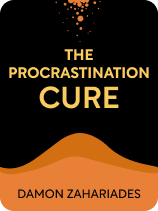

This article is an excerpt from the Shortform book guide to "The Procrastination Cure" by Damon Zahariades. Shortform has the world's best summaries and analyses of books you should be reading.
Like this article? Sign up for a free trial here.
Is it hard to get motivated to do work? What are the best tips to stop procrastinating?
Work and chores are rarely ever fun, but they have to be done. With the help of The Procrastination Cure by Damon Zahariades, you can finally stop procrastinating and get things done in a timely manner.
Here are ways to put an end to your procrastination habit.
1. Make Distractions More Difficult
The first of nine tips to stop procrastinating Zahariades recommends is to eliminate as many distractions from your environment as possible and make them harder to access. As he explains, this works because procrastination starts with the urge to put off an important task first, and then you look around for something to do instead. The goal is to minimize the options available for where to put your time and attention so that your only choice is to refocus on the task you need to do. Meanwhile, if you increase the amount of time and effort required to start doing distracting activities, even just a little, it will be easier to ride out the urge.
Zahariades offers these suggestions for minimizing distraction:
- From your computer: Use a website blocker to prevent you from going to the sites where you tend to waste time, delete bookmarks, or even turn off your internet temporarily.
- From your phone: Delete tempting apps, or better yet, keep your phone in a drawer when you need to focus.
- From your TV: Hide your remote somewhere hard to retrieve, like at the back of a closet.
(Shortform note: One option for limiting online distractions is a tool like the Freedom app, which lets you choose whether to block or allow specific websites, or cut yourself off from the internet altogether, across all of your devices. Other options include apps like Focus Dog or Forest, which simulate the costs of losing focus: You’re responsible for feeding a cute puppy or planting a tree, respectively, and you must stay on task to keep them alive.)
2. Make Focusing More Satisfying
Zahariades also offers several ways to set up reward systems to motivate you when the work doesn’t offer immediate rewards:
- Reward yourself when you overcome the urge to procrastinate and start a task.
- Earn rewards when you get things done. For example, you might win points for completing tasks and ultimately redeem those points for a prize.
- Turn a boring task into a game (gamification). There are apps that do this for you, or you can make up your own system, like timing yourself and trying to beat your record.
- Use “temptation bundling.” Match each task on your to-do list with an activity that you enjoy doing, which you can only do when you finish the required task.
(Shortform note: Gamification is a relatively new concept, and not everyone is convinced it’s effective. However, gamification apps are an increasingly popular option for those looking to increase their productivity. Some anecdotal evidence supports their effectiveness, and some scientific studies suggest these apps can increase your motivation to perform tasks you’d otherwise avoid. If you want to give it a try, Habitica is one popular app that turns your tasks and projects into a role-playing game. Completing quests and winning battles earns you gold coins, which you can then redeem for in-game or real-world rewards.)
3. Increase Consequences and Accountability
Zahariades has several suggestions for how to make the negative consequences of procrastination more of a deterrent. They all involve creating systems that will make sure you feel the effects of your choices right away, often by recruiting other people to hold you accountable. Here are some ideas:
- Think about the eventual outcomes of procrastinating (such as feeling overwhelmed and stressed, scrambling to meet deadlines, or missing them entirely), so it will be harder to justify doing it.
- Tell an accountability partner when you plan to complete a task and ask them to follow up with you about it.
- Use a “commitment device” that limits other options or creates an immediate consequence to raise the stakes of not doing the task. For example, ask a friend to post an embarrassing video of you online if you don’t meet your deadline, or have your partner hide your car keys so you won’t be able to leave the house until you finish your work.
(Shortform note: Returning to the showdown between Present You and Future You, involving other people in your process to hold you accountable is like recruiting more players for Team Future You—but for Team Future You to win, you need the right teammates and the right game plan. When choosing your accountability partner, make sure they’re willing to hold your feet to the fire, even when it’s uncomfortable. Decide together how often you’ll talk about your progress, and empower them to speak up if they notice you’re procrastinating.)
4. Build the Habit of Doing the Work
Zahariades suggests that instead of waiting to feel motivated, you should practice taking action regardless of how you feel until it becomes a habit. On a daily basis, the first task you do should be the one you dread the most. For larger goals, focus on the process rather than the product: If you establish a consistent routine for how and when you’ll work on the task, eventually your effort will produce the result you want.
(Shortform note: Like Zahariades, James Clear recommends you concentrate on improving your process instead of achieving a certain outcome. In Atomic Habits, he distinguishes among goal-driven habits, system-driven habits, and identity-driven habits—behaviors in pursuit of a goal (like acing a test), process (like studying regularly), or identity (like being a good student), respectively. Clear notes that the problem with goal-driven habits, or the behavior you adopt to achieve a specific outcome, is they’re limited in scope. System-driven habits, on the other hand, put a process in place that will indefinitely produce the outcomes you want—and that system is likely to help you consistently do your work, regardless of your motivation level.)
5. Overcome the Fears That Hold You Back
Zahariades suggests that the emotional culprit behind most procrastination is fear. This fear can take many forms, he explains:
- Fear of failure: When a task involves something you don’t have much experience doing, you don’t believe you’re good at, or that reminds you of a past experience that went badly
- Fear of success: When you’re not sure you can live up to high expectations, you feel you haven’t earned your success, or you’re nervous about what might come after success (like a bigger workload or more intense scrutiny)
- Perfectionism, or fear of imperfection: When the risk of a less-than-perfect outcome is so unbearable that you avoid the task altogether
To help you overcome these challenges, Zahariades suggests shifting your perspective, or applying logic to expose your anxiety as irrational:
- Reframe failure as useful information that your approach isn’t working, which gives you a chance to make adjustments.
- Be specific about your fears, and evaluate how realistic they are.
- Recognize that the difference between a perfect outcome and an almost perfect one is negligible.
- Reflect on how perfectionism stresses you out and prevents you from taking action. Then ask yourself why you need things to be perfect.
6. Remove Your Brain’s Barriers to Action
Zahariades says negative self-talk—when your internal voice is critical or full of worry—can trigger procrastination by undermining your self-confidence, making you reluctant to act. You can combat negative self-talk by disputing it and replacing it with a more realistic perspective.
7. The Lists You Need to Succeed
There are at least three lists Zahariades suggests you maintain. First, make a list of your short-, medium-, and long-term goals. Next, create a master to-do list of all your commitments. Use this to create your daily to-do list, which includes only the things you’re planning to do today. The final organizational component is a calendar where you can keep track of appointments and plan out your day. Next, we’ll take a closer look at how to use these tools.
8. Get Clear on Your Goals and Priorities
To prevent your to-do lists from becoming cluttered or outdated as priorities change, Zahariades recommends you revisit them regularly with the following tips in mind:
- Review your master to-do list every week, alongside your goals list, and remove or re-prioritize items as appropriate so your list never gets cluttered.
- Assign every item on your to-do list a priority level. Use your goals list to evaluate which tasks are most important to your goals and which are urgent.
- Limit your daily to-do list to seven items or fewer so that you can actually accomplish everything on the list. Review the list each morning and remove any non-essential tasks.
9. Scheduling and Time Management
Zahariades recommends several practices that increase your awareness of and control over how you spend your time and tackle your to-do list:
- Decide ahead of time how you’ll schedule your day, including what tasks you’ll work on when, so that you only take free time as planned.
- Set a time limit for every task on your to-do list. Then shorten the time, recognizing that work will expand to fill the time you allow for it.
- Split up long blocks of time into manageable chunks with breaks in between each one. Use a timer to keep track. Group similar tasks together.
- Track your energy levels at different times of day to understand when you usually feel most energetic, and schedule your most challenging tasks for those times.
- Stop multitasking. Doing more than one thing at once doesn’t make you more productive, but it gives you a false sense that you’re getting a lot done.

———End of Preview———
Like what you just read? Read the rest of the world's best book summary and analysis of Damon Zahariades's "The Procrastination Cure" at Shortform.
Here's what you'll find in our full The Procrastination Cure summary:
- Advice from a former chronic procrastinator on how to stop procrastinating
- How to get to the bottom of what drives you to procrastinate
- How to use lists and schedules to manage your time and tasks






